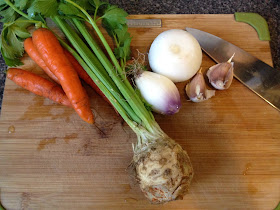Check out this recipe on my new and improved website: thewalkingcookbook.com
Ahh, Pisticci. Or in my cool person lingo, "Pisteech."
I have memories of apartment hunting a few years ago, making my way uptown on the 1 train with an arrogant real estate broker who kept talking about his place on Central Park West. I get it, sir. You are wealthy. As the train moved above ground at 125th Street, he pointed out the window and said, "See that little street? Best Italian place is right up there, and you'd never expect it in this neighborhood." While I did not get my next apartment from him (10% broker's fee? No thanks!), I did get a new spot on my list of must-try restaurants. Fortunately I had the luxury of being walking distance from it for about a year, and I was thisclose to being a regular.
Although it is no longer in my neighborhood, Pisticci is a destination worth traveling to. Oh, and did I mention it is NYC's first carbon neutral restaurant? When I started eating meat again and learned that I knew nothing about lamb, the Maltagliati with Ricotta, Spinach, and Lamb was something I decided to try. Could you resist with a description like this?
It was fabulous! So with nothing but the menu description and my one experience eating it at the restaurant, I decided to give it a go at home. I made my own pappardelle (can't really have maltagliati without pasta scraps), but most gourmet grocery stores have fresh pasta you can buy.
Try it on your own, send your thoughts, and when you are in New York come try it in person!
Pappardelle with Lamb Ragu and Ricotta
A Walking Cookbook original recipe inspired by Pisticci
Recipe assistance from Bon Appetit and Wikipedia
Prep Time: 20 min.
Cook Time: 60 min.
Serves 4-6
Ingredients:
- 2 tbsp butter
- 2 tbsp olive oil
- 2/3 cup carrot, finely chopped
- 2/3 cup celery, finely chopped
- 2/3 cup onion, finely chopped
- 2 cloves garlic, minced or grated
- 2 tsp dried thyme
- 2 tsp dried oregano
- 2 tsp dried basil
- 1 lb lamb shoulder, cut into cubes
- 1 small can tomato paste
- 1 cup red wine
- 2 cups chicken broth
- salt and pepper, to taste
- 1/2 cup ricotta cheese
- 1 lb wide, flat pasta (fresh tagliatelle or pappardelle preferable-- here's how)
Mise en Place (prework for those of us who can't multitask):
1. Chop carrots, celery, and onion finely
2. Mince or grate garlic
3. Measure the dried herbs into the same container.
4. Measure wine and chicken broth in separate containers.
5. Cut the lamb shoulder into cubes. I have no tips for doing this... my process wasn't pretty.
6. Fill a pot with salted water so it is ready to boil when you want to cook the pasta.
Preparation:
1. Heat a sautee pan to medium and add the butter and oil.
2. Once the butter is melted, add the garlic, carrot, celery, and onion. Cook on low for 6 minutes, stirring frequently, until slightly softened but not browned. Onions should be translucent.
3. Push the veggies to the side of the pan and increase the heat to medium. Add the lamb cubes and the bone piece if it still has meat on it. Cook for 1 minute on each side to brown the meat. Add the herbs and some salt and pepper.
4. Once the lamb is browned, scoop in the tomato paste and give it a quick stir. Then add the wine and broth, and stir well.
5. Bring the sauce to a low boil, then reduce to a simmer and cover. Cook for 40-50 minutes, turning any pieces of lamb that are not covered by liquid every 10 minutes or so).
6. Once the sauce has been simmering for 35 minutes or so, bring a pot of salted water to a boil. Add the pasta and cook 3-4 minutes for fresh pasta (dried pasta can cook according to the package).
7. Turn off the heat on the pasta and the sauce. With tongs or a pasta serving spoon, transfer the cooked pasta directly into the pan of sauce. Stir well.
8. Serve with a large dollop of ricotta cheese.
 |
| All veggies came from my CSA! |
 |
| Mise en place... everything in its place, ready to cook |























